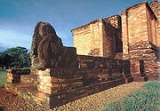
Candi Muaro Jambi
Encyclopedia
Muaro Jambi is a Buddhist temple
complex, in Jambi province, Sumatra
, Indonesia
. The temple complex was built by the Melayu Kingdom
. It is situated 26 kilometers east from the city of Jambi
. Its surviving temples and other archaeological remains are estimated to date from the eleventh to thirteenth century AD. The archaeological site includes eight excavated temple sanctuaries and covers about 12 square kilometers, stretches 7.5 kilometers along the Batang Hari River
, much of it as yet unexcavated. It is one of the largest and best-preserved ancient temple complex in South East Asia.
. This allowed a number of smaller Sumatran polities to expand their political and economic influence. During the twelfth and thirteenth centuries it seems that from its river estuarine basis along the Batang Hari, Melayu became the dominant economic power in Sumatra. The substantial archaeological remains at Muaro Jambi suggest that this may have been the site of the Melayu capital. The city's age of glory came to an end in 1278 when Java's Singhasari
kingdom attacked the city, even succeeding in capturing members of the royal family. The site was rediscovered by Dutch explorers in the nineteenth century. It is now protected as a national monument.
Temple
A temple is a structure reserved for religious or spiritual activities, such as prayer and sacrifice, or analogous rites. A templum constituted a sacred precinct as defined by a priest, or augur. It has the same root as the word "template," a plan in preparation of the building that was marked out...
complex, in Jambi province, Sumatra
Sumatra
Sumatra is an island in western Indonesia, westernmost of the Sunda Islands. It is the largest island entirely in Indonesia , and the sixth largest island in the world at 473,481 km2 with a population of 50,365,538...
, Indonesia
Indonesia
Indonesia , officially the Republic of Indonesia , is a country in Southeast Asia and Oceania. Indonesia is an archipelago comprising approximately 13,000 islands. It has 33 provinces with over 238 million people, and is the world's fourth most populous country. Indonesia is a republic, with an...
. The temple complex was built by the Melayu Kingdom
Melayu Kingdom
Melayu Kingdom was a classical Southeast Asian kingdom that existed between the 7th and the 13th century of the common era. It was established around present-day Dharmasraya on Sumatera, Indonesia, approximately 300 km north of Palembang...
. It is situated 26 kilometers east from the city of Jambi
Jambi (city)
Jambi is a city in Indonesia, capital of Jambi province, on the island of Sumatra. The city is a busy port on the Batang Hari River and an oil- and rubber-producing centre...
. Its surviving temples and other archaeological remains are estimated to date from the eleventh to thirteenth century AD. The archaeological site includes eight excavated temple sanctuaries and covers about 12 square kilometers, stretches 7.5 kilometers along the Batang Hari River
Batang Hari River
The Batang Hari is the longest river in Sumatra, Indonesia. It originates in the Minangkabau highlands and flows to the east coast of Sumatra. The city of Jambi is located at the mouth of the river.-External links:...
, much of it as yet unexcavated. It is one of the largest and best-preserved ancient temple complex in South East Asia.
History
The start of the rise of the kingdom of Melayu can be dated to 1025 when India's Chola kingdom attacked and destroyed the capital of the Sumatran maritime empire of SrivijayaSrivijaya
Srivijaya was a powerful ancient thalassocratic Malay empire based on the island of Sumatra, modern day Indonesia, which influenced much of Southeast Asia. The earliest solid proof of its existence dates from the 7th century; a Chinese monk, I-Tsing, wrote that he visited Srivijaya in 671 for 6...
. This allowed a number of smaller Sumatran polities to expand their political and economic influence. During the twelfth and thirteenth centuries it seems that from its river estuarine basis along the Batang Hari, Melayu became the dominant economic power in Sumatra. The substantial archaeological remains at Muaro Jambi suggest that this may have been the site of the Melayu capital. The city's age of glory came to an end in 1278 when Java's Singhasari
Singhasari
Singhasari was a kingdom located in east Java between 1222 and 1292. The kingdom succeeded Kingdom of Kediri as the dominant kingdom in eastern Java.-Foundation:...
kingdom attacked the city, even succeeding in capturing members of the royal family. The site was rediscovered by Dutch explorers in the nineteenth century. It is now protected as a national monument.
Design and decoration
The temple complex of Candi Muaro Jambi is spread out over a large area along the banks of the Batang Hari River. Eight temple compplexes have been excavated but many more mounds and sites remain to be explored within the conservation area, much of which is still covered by thick jungle. The three most significant intact temples are known as Candi Tinggi, Candi Kedaton and Candi Gumpung. The temples are built from red brick and unlike the temples of Java, features very little ormentation, carving or statuary. A few pieces of sculpture are housed in a small, on-site museum. The wooden dwellings that are believed to have housed the city's population have all disappeared without a trace.See also
- Candi of IndonesiaCandi of IndonesiaCandi are the Hindu and Buddhist temples and sanctuaries of Indonesia, mostly built during the 8th to 15th centuries...

